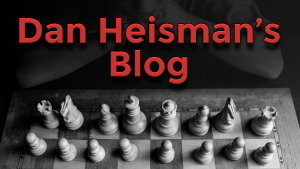Q&A with Coach Heisman Jul 19, 2013
Two of the questions on today's show were:
1) Give us an example of how you evalute a position, and
2) What do you think about the line 1.e4 e6 2.d4 d5 3.Nd2 b6 (a fairly rare variation of the French Defense, Tarrasch Variation)?
I did not have a lot of time to answer either in detail but let's see if we can kill two birds with one stone by examining the game Heisman-M.Shahade, Batoff Invitational 1977 (this was a warmup for the World Open):
In particular, let's evaluate the position after White's 16th move:
The four evaluation criteria I like to use are:
1. Material balance
2. King safety (if there is a big difference this can become more important than material)
3. Activity of the two armies, and
4. Pawn structure.
So let's take one at a time. We also have to take dynamics into consideration. It is White's move. If White has a forcing sequence, then we really can't do good evaluation til we reach quiescence (or at least a speculative sacrificial evaluation). Luckily in this case White does not have a forcing sequence starting with move 17, so we can evaluate the position statically.
1. Material - I guess many would think this is even, but it's not. White has the bishop pair, worth on average about half a pawn. In this position the white bishops are both quite good, so the full half pawn is warranted.
2. King safety - White's king is a little safer since the light squares around the black king are a little airy.
3. Army activity - White already has his queen out and Black's knight on f6 is pinned, but Black's f-rook is the only one currently on an open or semi-open file. I would say at most a slight advantage to White. If you want to know about space, check out Activity is the Real Goal.
4. Pawn structure - White has three on two on the kingside, Black has 4-3 on the queenside. It's easier to get the queenside rolling here and Black has the only central (d/e) pawn. Slight advantage to Black.
These four should add up to at least a slight advantage to White. I am going to let Houdini 3 think for 20 ply. My guess is that White's advantage should be right around half a pawn. Let's see if the computer makes me look good...Nope - it says that White is ahead by +0.94 pawns so I should have paid more attention to my bottom line of the bishop pair plus a little else! The delineation for an evaluation indicating White is possibly winning using Houdini at this point in a game is probably around +1 pawn. Therefore, if we had to guess, it might be possible that with perfect play on both sides (which is what an evaluation assumes!) White might be able to win here, but it would be close. I did play Houdini's #1 move, 17.Rfe1, activating the rook onto the open file; that sounds easy but a lot of my students try to make it more difficult and often come up with strange moves like 17.Bh7+ or 17.Bf5, neither of which solve White's main goal, which is to get all his pieces into play as quickly and efficiently as possible - here the rooks. Sometimes chess is not that hard. The two rooks are the two pieces not doing anything? Then get those two pieces into the game right away! Put them on open (and possibly semi-open) files. Those open files not there? Put them behind where the Break Moves are going to be or on the same file where the opponent developed his queen.
I gotta give Mike Shahade his props though - this was the only game (out of about 5) that I ever beat him - may have squeezed in a draw or two. Mike, of my generation, holds the FM title but his kids did him better: son Greg is an IM and the Commissioner of the US Chess League and daughter Jennifer is two-time US Women's Chess Champion and editor of Chess Life online.
I remember one game at the Germantown Chess Club where I played a Blackmar Diemar Gambit and played an early Qg3, attacking Mike's g-pawn. The only problem was that I was not castled, did not have an f-pawn, and Mike had a queen on d8 and bishop on e7 (here is the bare-bones part of the position, which occurred in the opening and many more pieces on the board):
 and I thereupon immediately resigned. One of my quickest and most embarrassing losses once I became a decent player...
and I thereupon immediately resigned. One of my quickest and most embarrassing losses once I became a decent player...
When I do the show, I try to not only discuss any links involved with the answer, but also show the linked page on video AND copy and paste the URL onto the chat channel. As regular viewers know, a fair percentage of questions already have extensive answers in one or more Novice Nook columns. That's OK; it gives me a chance to give a brief, overview answer and refer everyone to a more detailed discussion of the issue (often necessary, but not possible "live" on the show unless we want to spend 15+ minutes answer each of many questions). Good publicity, too .
.
Nevertheless, you can't please everyone and one newcomer to the show typed something to the effect "What's this Novasnook? I have no idea what this guy is talking about." Of course, I had put all the Novice Nook links on the channel as well as the generic link for all, as provided here. One thing you learn quickly when dealing with large groups of people: you can't please everyone all the time. We try to make the show light and informative, get as many different viewer questions as possible, and talk toward the middle-level viewer. But sometimes I do get a little more basic or advanced for those viewers at those levels and I hope everyone understands.
I had a couple of questions about teaching young beginners - must be summer chess camp time. I do have an article about that (surprise!), but I also took about 5 minutes and went thru some of the "Is it Safe?" and "Counting" sequences I think need to be taught all beginners. I've said it a million times and I will say it again: "I don't understand teaching sophisticated motifs like pins, forks, and removal of the guard to beginners before you teach them how to keep track of whether a piece is safe simply from a series of captures where it stands!" So if they can't figure out if a "he takes - I take - he takes" sequence might lead to loss of material, there's no sense showing a clever double attack! Watch any two beginners play and many of their errors will be leaving pieces en prise and succumbing to simple errors by allowing capturing sequences that win material (or, similarly, missing ones that would).
The set of capturing sequences I used to illustrate what you might teach to beginners of all ages can be found in my Everyone's Second Chess Book but also free to all on pages 4-7 of A Counting Primer. Use it all you want (and make similar problems of your own) when teaching beginners - but do give Chess Cafe its proper due since they own the rights to this material!
Several times during the show I emphasized the improvement triangle: Study, practice (play), and get feedback. A computer can feedback on tactical errors and an opening book or database can feedback on the opening, but it usually takes a much stronger player to feedback on other things you don't understand or mis-apply. I've never seen a book tell a player "Yes, you know this opening well but the time limit was 45 45, the game lasted 40 moves, and at the end you had 73 minutes left - you're playing much too fast!" So this feedback aspect is critical - leave off any part of the triangle and your improvement eventually runs into severely diminishing returns. See my articles The Theory of Chess Improvement and especially The Improvement Feedback Loop.
I got asked about a bunch of openings. One to mention is the Stonewall Opening for White: roughly 1.d4 2.e3 3.f4 4.Nf3 5.c3 6.Bd3 7.O-O in some order. The Stonewall is pretty much never seen at the top GM level because it does not promise much advantage for White when defended correctly (as I mentioned, the Colle System falls into this category, too), can be tough for class players under 1700 to meet. I have seen many instances in club and tournament play where someone with a rudimentary knowledge of the Stonewall gets a nice advantage for White out of the opening, often a dangerous kingside attack. Many openings are like this: just because the GMs don't play them for one reason or another doesn't mean they can't be effective weapons at the class level. For more on this important notion see Soltis' recommended (for those 1600+) book Grandmaster Secrets: Openings.
It's also worth mentioning that Chess.com's Dan Heisman Learning Center and I are sponsoring a 3-1 matching donation charity fund drive for the Chess Support Fund at the Philadelphia Foundation until July 31. More information at this link. Please consider a tax-deductible donation for a good cause - thanks!
The next show on Aug 2 will be for Diamond and Platinum Members only. That makes it easier to get your questions answered  .
.



